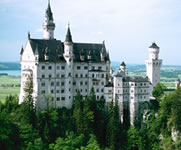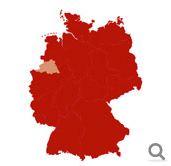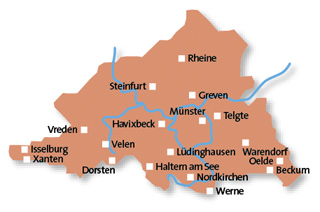Historical Towns
- Historical towns in Brandenburg
- Cathedral Towns and Cities in Saxony-Anhalt
- The innovative Anhalt-Wittenberg Region
- Enchanting towns in the Harz
- The beautiful towns and cities in Saxony
- Towns and cities of culture in Thuringia
- Beautiful towns of Franconia
- East Bavarian traditional towns
- Alpine towns in the Allg�u
- The eastern Akpine Foothills and their towns
- Towns and villages in the western foothills of the Alps
- Mediterranean towns on Lake Constance
- Towns in the Swabian Alb
- Unspoilt towns in the Black Forest
- Towns for refined tastes in the Heilbronner Land
- Towns in the Odenwald
- Wine towns in Rheinhessen
- Saarland, a region of contrasts
- Romantic towns in the Hunsr�ck and Nahe Regions
- Idyllic towns and villages in the Moselle Region
- The Ahr Rhine Eifel holiday region
- Wine towns on the Romantic Rhine
- Modern towns and cities in the Bergisches Land Region
- The Lahn Valley and its fairytale towns
- Historical towns in Kurhessisches Bergland
- Sauerland's scenic towns
- Fairytale towns in the Weserbergland Hills
- Majestic towns in the M�nsterland Region
- The nine stars of Lower Saxony
- North and East Frisian Islands
- Vibrant Schleswig-Holstein
- Maritime towns along Mecklenburg's Baltic Coast
- Historical Hanseatic Towns
- Germany's Baltic Sea Islands
- The Mecklenburg Lakes
Contact and information
A paradise for cyclists passing one hundred castles and palaces
Historical towns
The Münsterland region is full of idyllic villages and delightful towns. An excursion to Werne is well worth your while with its pretty half-timbered houses and Gothic town hall. There is plenty to discover in the picturesque town of Warendorf including the medieval market square, St. Lawrence's Church and the Franciscan abbey. Beckum's favourable location at the crossroads of two trade routes has brought the town modest prosperity since the Middle Ages, which is most evident from its old town hall where the municipal museum is now located. Westphalia's most exquisite reliquary shrine, the Prudentia shrine, is kept in the Parish Church of St. Stephen and St. Sebastian and you can visit a museum forge in the Kolpinghaus. Many nearby towns with historical old quarters are deserving of a visit such as Oelde, Telgte and Emsdetten.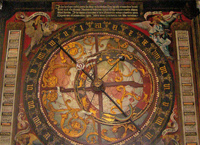
Münster Cathedral
The Cathedral of St. Paul in Münster is almost as old as the city itself, which was first settled in the 6th century AD. The monastery, founded in the 8th century AD, is thought to have given the town its name. Münster Cathedral is the centre of the diocese. It houses an astronomical clock from 1540, a handcrafted masterpiece displaying the phases of the moon and zodiacal constellations, with a carillon and a perpetual calendar that goes up to the year 2071.Münsterland
The name Kiepenkerle was given to the peddlers in the Münsterland region, who used to travel around towns and villages selling their wares to local people. They were typically equipped with panniers (Kiepe in German) made from wood or wickerwork. The Kiepenkerle with their trademark blue tunics and clogs have been an important part of Münsterland tradition for a long time. Although their days are over, they have not been forgotten and you will often see tour guides dressed in their distinctive costume.The Battle of the Teutoburg Forest
An autumn day in 9 AD has gone down in the annals of history as the date of the Battle of the Teutoburg Forest or the Varus Battle, when the Romans suffered a crushing defeat in their northern territories. It is believed that Hermann the Cheruscan (Arminius) and his alliance of Germanic tribes annihilated three Roman legions together with auxiliary troops and followers on Kalkriese Hill near Osnabrück. The victory ended the Romans' efforts to conquer lands east of the Rhine for their empire. But how did the Battle of the Teutoburg Forest come about? Embark on a journey of discovery in a holiday region that opens the way to a treasure trove of history. Walkers and cyclists can choose from the many themed trails and routes that offer fascinating insights and excellent views.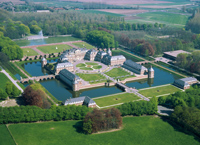
A hundred castles and palaces by bike
Flat terrain and many themed cycle routes make Münsterland an ideal destination for cycling holidays. More than 4,500 kilometres of signposted cycle paths are incorporated into its network of trails. The 100 Castles and Palaces Route is the most glorious of all: around 960 kilometres in total, it takes you through well-maintained parkland and conservation areas to castles, palaces, manor houses and the moated estates so characteristic of the region. The tour takes in the palatial houses at Nordkirchen, Raesfeld, Lembeck and Westerwinkel as well as the castles at Vischering, Bentheim and finally Münster, the bicycle capital of Germany.Münsterland cuisine
Töttchen is a speciality in the Münsterland region. This sweet and sour ragout was originally made from beef offal prepared with onions and vinegar. Today a somewhat refined and modified version of the dish is available in many local restaurants. Instead of offal, it is made with veal and calf's tongue.Travel Planner
Select an option...
Romance and charm
Mainland Europe's only surviving herd of wild horses lives in the Merfelder Bruch. The large reserve (now over 350 ha.) with around 300 horses dates back 150 years to an initiative by the Dukes of Croy to create a conservation area for the animals.
Food and drink
Around 60 restaurateurs are making dining out in the Münsterland region an experience to remember. Each one contributes to the Regionale Speisekarte (regional menu) campaign. There's always something new to discover made exclusively with local produce.
History and tradition
Bocholt Textile Museum acquaints you with the textile production of yesteryear. At the heart of the complex is the production hall with its saw-tooth roof, which was characteristic of the original textile factories.
Nature and scenery
Vreden is home to the most northerly flamingo colony in Europe. The Flamingo Route, part of Zwillbrock's biological research station, has more than 300km of cycle paths and 30km of walking trails leading to the observation towers.
 Skip to content
Skip to navigation
Skip to subnavigation
Skip to search
Skip to content
Skip to navigation
Skip to subnavigation
Skip to search




